Leadership and Management Report: Retail Sector and Behavioral Science
VerifiedAdded on 2022/10/11
|18
|4825
|12
Report
AI Summary
This report delves into the critical role of leadership and management within the dynamic retail industry, emphasizing the application of behavioral science principles. It examines how leadership techniques, particularly those rooted in behavioral science, can significantly impact business processes and drive success in the retail sector. The report explores the changing landscape of the retail industry, highlighting the challenges and opportunities presented by evolving consumer behaviors and preferences. It investigates the use of behavioral science leadership techniques, such as nudge marketing, to influence customer choices and improve strategies. Furthermore, it provides a systematic approach to changing behavioral patterns within organizations, emphasizing the importance of identifying key behaviors, developing step-by-step plans, measuring results, and providing positive reinforcement. The report underscores the importance of understanding customer perception and leveraging behavioral data to optimize product offerings and enhance customer experiences. Ultimately, the report provides valuable insights into how retail leaders can adapt to the evolving market and drive continuous growth by embracing behavioral science principles.
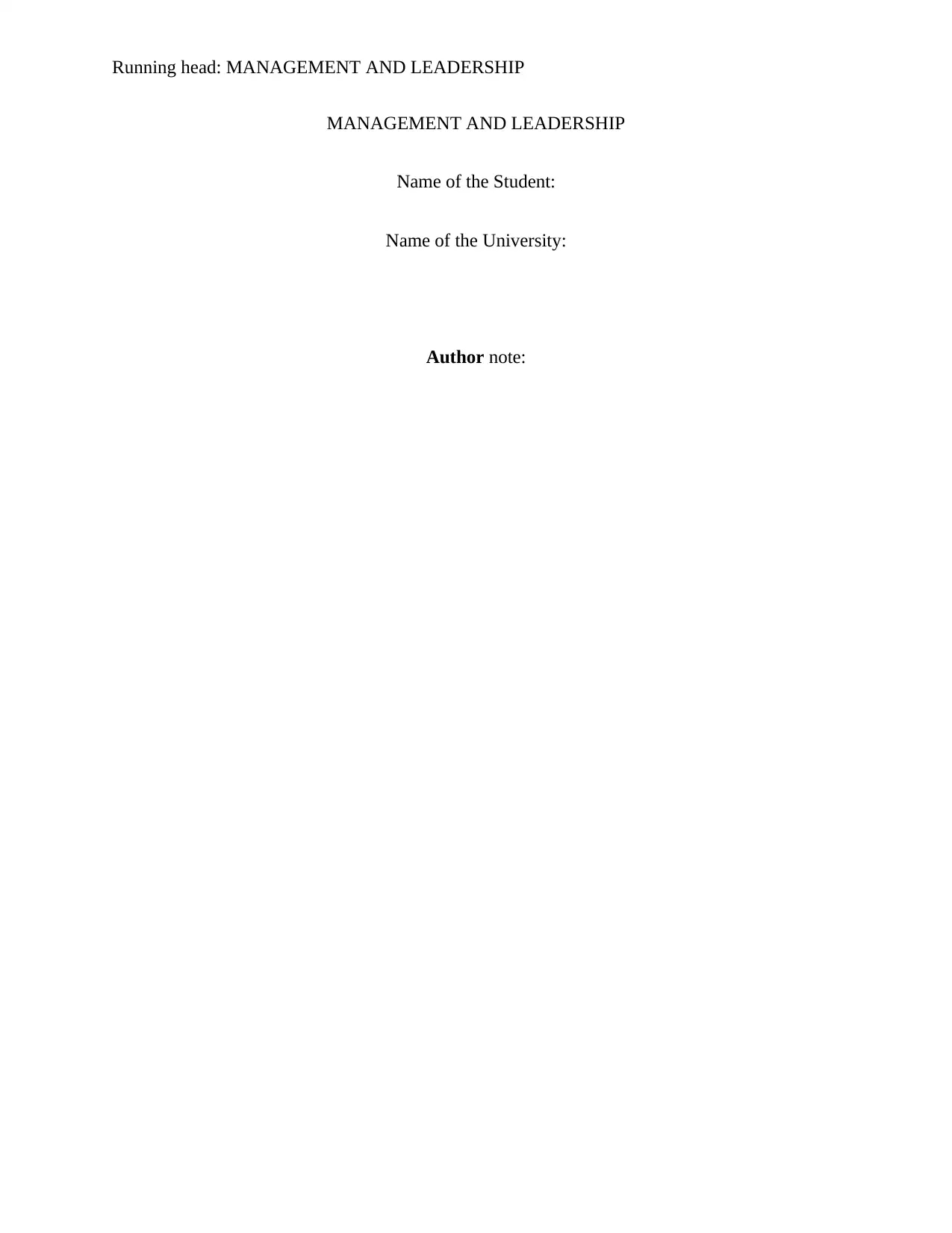
Running head: MANAGEMENT AND LEADERSHIP
MANAGEMENT AND LEADERSHIP
Name of the Student:
Name of the University:
Author note:
MANAGEMENT AND LEADERSHIP
Name of the Student:
Name of the University:
Author note:
Paraphrase This Document
Need a fresh take? Get an instant paraphrase of this document with our AI Paraphraser
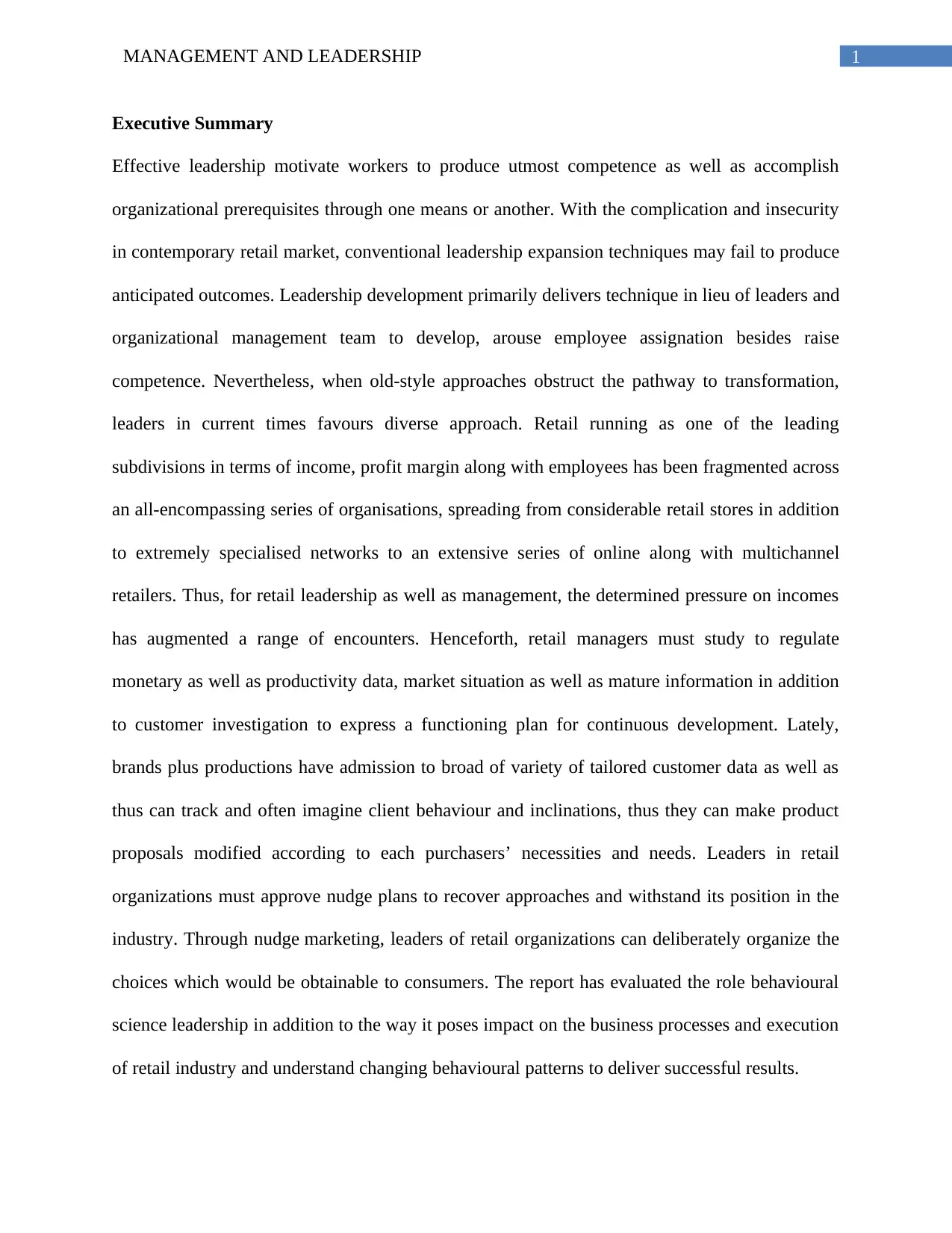
1MANAGEMENT AND LEADERSHIP
Executive Summary
Effective leadership motivate workers to produce utmost competence as well as accomplish
organizational prerequisites through one means or another. With the complication and insecurity
in contemporary retail market, conventional leadership expansion techniques may fail to produce
anticipated outcomes. Leadership development primarily delivers technique in lieu of leaders and
organizational management team to develop, arouse employee assignation besides raise
competence. Nevertheless, when old-style approaches obstruct the pathway to transformation,
leaders in current times favours diverse approach. Retail running as one of the leading
subdivisions in terms of income, profit margin along with employees has been fragmented across
an all-encompassing series of organisations, spreading from considerable retail stores in addition
to extremely specialised networks to an extensive series of online along with multichannel
retailers. Thus, for retail leadership as well as management, the determined pressure on incomes
has augmented a range of encounters. Henceforth, retail managers must study to regulate
monetary as well as productivity data, market situation as well as mature information in addition
to customer investigation to express a functioning plan for continuous development. Lately,
brands plus productions have admission to broad of variety of tailored customer data as well as
thus can track and often imagine client behaviour and inclinations, thus they can make product
proposals modified according to each purchasers’ necessities and needs. Leaders in retail
organizations must approve nudge plans to recover approaches and withstand its position in the
industry. Through nudge marketing, leaders of retail organizations can deliberately organize the
choices which would be obtainable to consumers. The report has evaluated the role behavioural
science leadership in addition to the way it poses impact on the business processes and execution
of retail industry and understand changing behavioural patterns to deliver successful results.
Executive Summary
Effective leadership motivate workers to produce utmost competence as well as accomplish
organizational prerequisites through one means or another. With the complication and insecurity
in contemporary retail market, conventional leadership expansion techniques may fail to produce
anticipated outcomes. Leadership development primarily delivers technique in lieu of leaders and
organizational management team to develop, arouse employee assignation besides raise
competence. Nevertheless, when old-style approaches obstruct the pathway to transformation,
leaders in current times favours diverse approach. Retail running as one of the leading
subdivisions in terms of income, profit margin along with employees has been fragmented across
an all-encompassing series of organisations, spreading from considerable retail stores in addition
to extremely specialised networks to an extensive series of online along with multichannel
retailers. Thus, for retail leadership as well as management, the determined pressure on incomes
has augmented a range of encounters. Henceforth, retail managers must study to regulate
monetary as well as productivity data, market situation as well as mature information in addition
to customer investigation to express a functioning plan for continuous development. Lately,
brands plus productions have admission to broad of variety of tailored customer data as well as
thus can track and often imagine client behaviour and inclinations, thus they can make product
proposals modified according to each purchasers’ necessities and needs. Leaders in retail
organizations must approve nudge plans to recover approaches and withstand its position in the
industry. Through nudge marketing, leaders of retail organizations can deliberately organize the
choices which would be obtainable to consumers. The report has evaluated the role behavioural
science leadership in addition to the way it poses impact on the business processes and execution
of retail industry and understand changing behavioural patterns to deliver successful results.
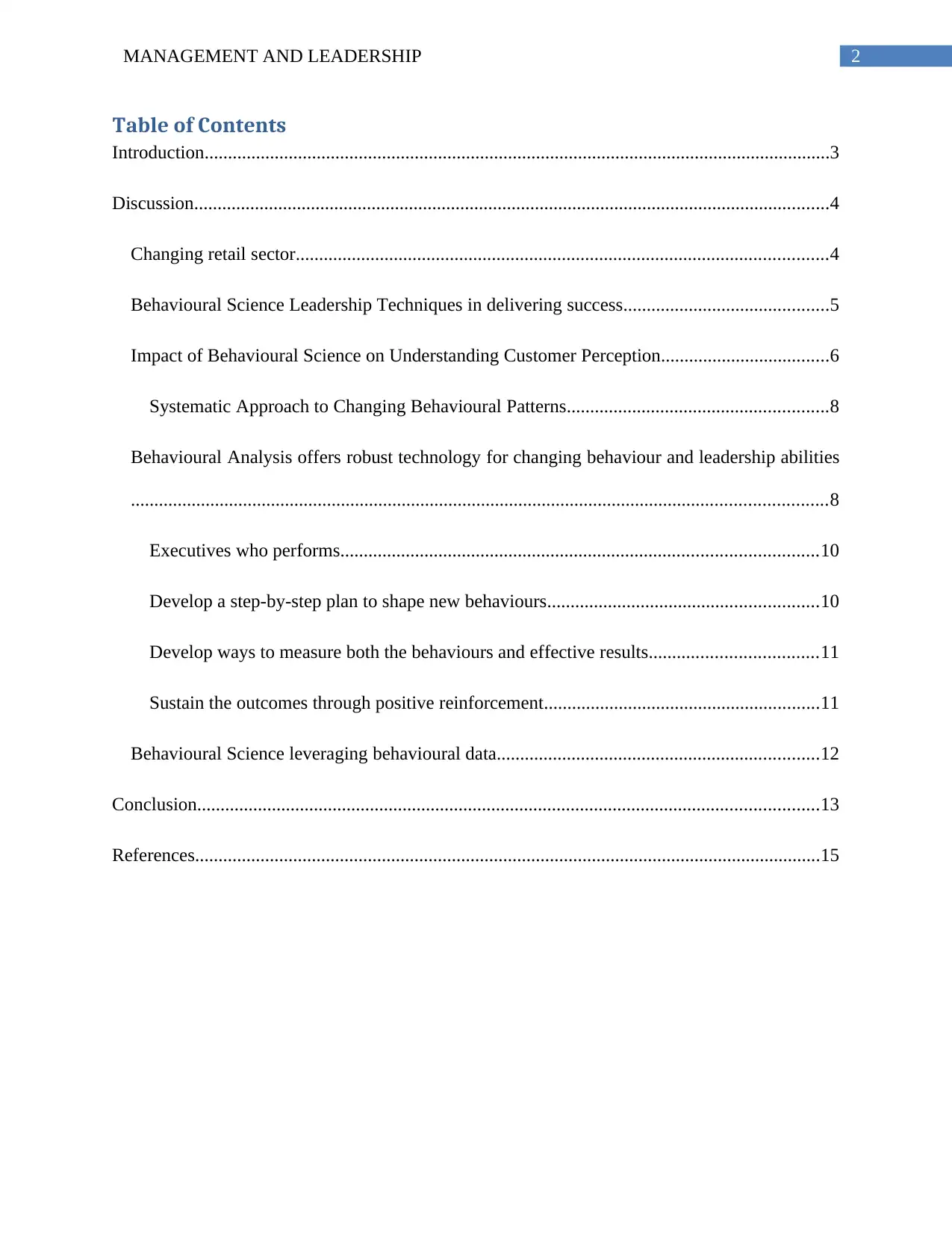
2MANAGEMENT AND LEADERSHIP
Table of Contents
Introduction......................................................................................................................................3
Discussion........................................................................................................................................4
Changing retail sector..................................................................................................................4
Behavioural Science Leadership Techniques in delivering success............................................5
Impact of Behavioural Science on Understanding Customer Perception....................................6
Systematic Approach to Changing Behavioural Patterns........................................................8
Behavioural Analysis offers robust technology for changing behaviour and leadership abilities
.....................................................................................................................................................8
Executives who performs......................................................................................................10
Develop a step-by-step plan to shape new behaviours..........................................................10
Develop ways to measure both the behaviours and effective results....................................11
Sustain the outcomes through positive reinforcement...........................................................11
Behavioural Science leveraging behavioural data.....................................................................12
Conclusion.....................................................................................................................................13
References......................................................................................................................................15
Table of Contents
Introduction......................................................................................................................................3
Discussion........................................................................................................................................4
Changing retail sector..................................................................................................................4
Behavioural Science Leadership Techniques in delivering success............................................5
Impact of Behavioural Science on Understanding Customer Perception....................................6
Systematic Approach to Changing Behavioural Patterns........................................................8
Behavioural Analysis offers robust technology for changing behaviour and leadership abilities
.....................................................................................................................................................8
Executives who performs......................................................................................................10
Develop a step-by-step plan to shape new behaviours..........................................................10
Develop ways to measure both the behaviours and effective results....................................11
Sustain the outcomes through positive reinforcement...........................................................11
Behavioural Science leveraging behavioural data.....................................................................12
Conclusion.....................................................................................................................................13
References......................................................................................................................................15
⊘ This is a preview!⊘
Do you want full access?
Subscribe today to unlock all pages.

Trusted by 1+ million students worldwide
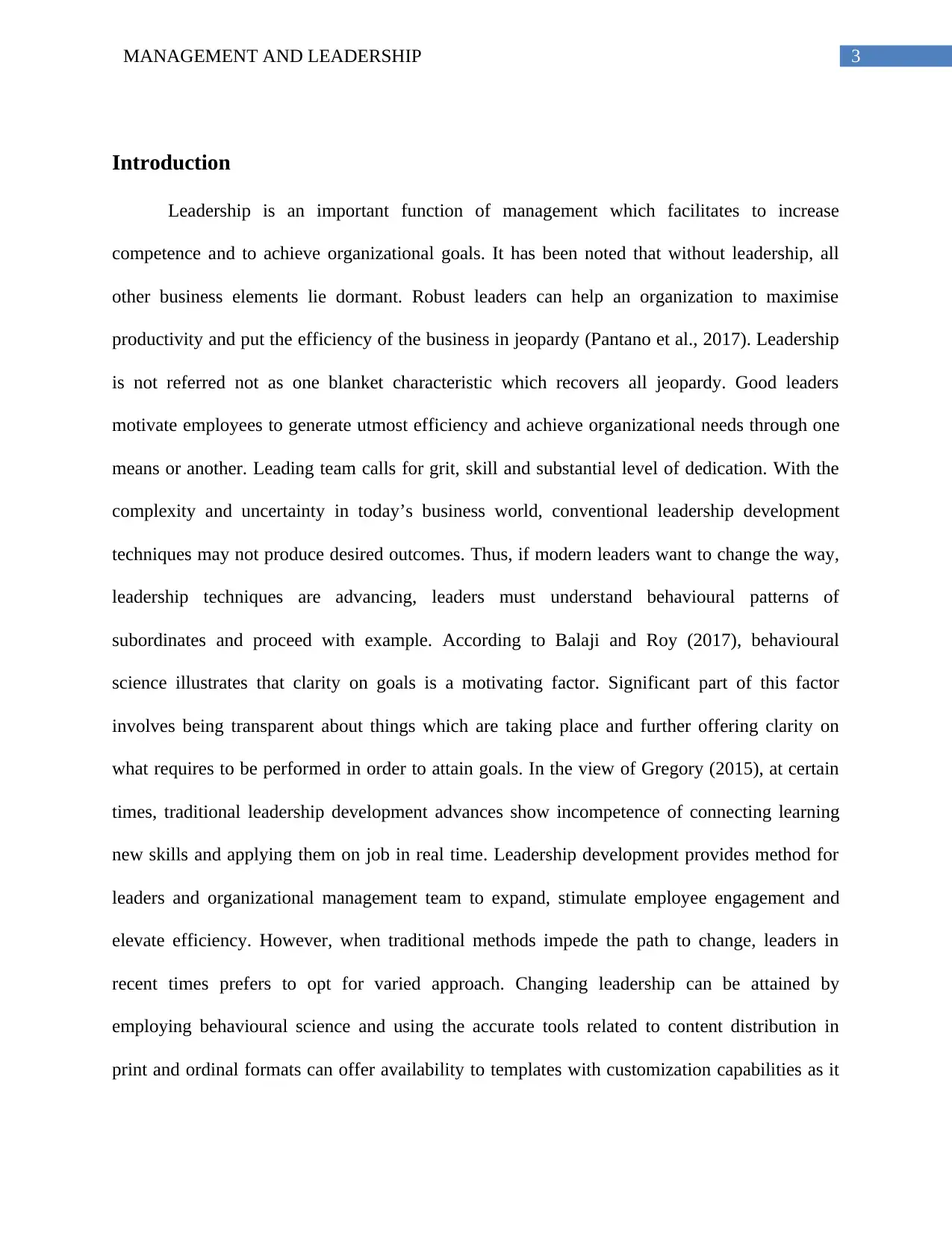
3MANAGEMENT AND LEADERSHIP
Introduction
Leadership is an important function of management which facilitates to increase
competence and to achieve organizational goals. It has been noted that without leadership, all
other business elements lie dormant. Robust leaders can help an organization to maximise
productivity and put the efficiency of the business in jeopardy (Pantano et al., 2017). Leadership
is not referred not as one blanket characteristic which recovers all jeopardy. Good leaders
motivate employees to generate utmost efficiency and achieve organizational needs through one
means or another. Leading team calls for grit, skill and substantial level of dedication. With the
complexity and uncertainty in today’s business world, conventional leadership development
techniques may not produce desired outcomes. Thus, if modern leaders want to change the way,
leadership techniques are advancing, leaders must understand behavioural patterns of
subordinates and proceed with example. According to Balaji and Roy (2017), behavioural
science illustrates that clarity on goals is a motivating factor. Significant part of this factor
involves being transparent about things which are taking place and further offering clarity on
what requires to be performed in order to attain goals. In the view of Gregory (2015), at certain
times, traditional leadership development advances show incompetence of connecting learning
new skills and applying them on job in real time. Leadership development provides method for
leaders and organizational management team to expand, stimulate employee engagement and
elevate efficiency. However, when traditional methods impede the path to change, leaders in
recent times prefers to opt for varied approach. Changing leadership can be attained by
employing behavioural science and using the accurate tools related to content distribution in
print and ordinal formats can offer availability to templates with customization capabilities as it
Introduction
Leadership is an important function of management which facilitates to increase
competence and to achieve organizational goals. It has been noted that without leadership, all
other business elements lie dormant. Robust leaders can help an organization to maximise
productivity and put the efficiency of the business in jeopardy (Pantano et al., 2017). Leadership
is not referred not as one blanket characteristic which recovers all jeopardy. Good leaders
motivate employees to generate utmost efficiency and achieve organizational needs through one
means or another. Leading team calls for grit, skill and substantial level of dedication. With the
complexity and uncertainty in today’s business world, conventional leadership development
techniques may not produce desired outcomes. Thus, if modern leaders want to change the way,
leadership techniques are advancing, leaders must understand behavioural patterns of
subordinates and proceed with example. According to Balaji and Roy (2017), behavioural
science illustrates that clarity on goals is a motivating factor. Significant part of this factor
involves being transparent about things which are taking place and further offering clarity on
what requires to be performed in order to attain goals. In the view of Gregory (2015), at certain
times, traditional leadership development advances show incompetence of connecting learning
new skills and applying them on job in real time. Leadership development provides method for
leaders and organizational management team to expand, stimulate employee engagement and
elevate efficiency. However, when traditional methods impede the path to change, leaders in
recent times prefers to opt for varied approach. Changing leadership can be attained by
employing behavioural science and using the accurate tools related to content distribution in
print and ordinal formats can offer availability to templates with customization capabilities as it
Paraphrase This Document
Need a fresh take? Get an instant paraphrase of this document with our AI Paraphraser
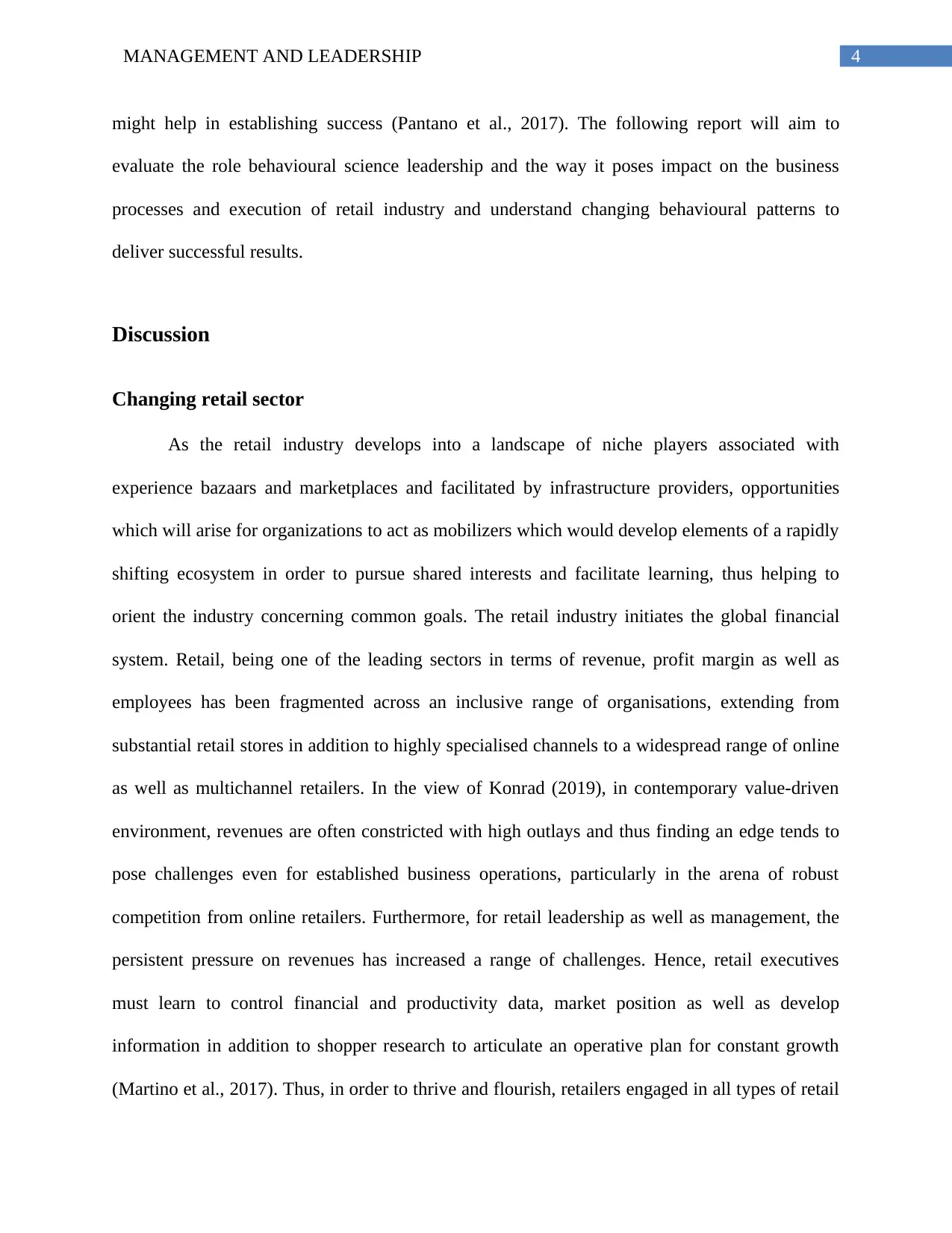
4MANAGEMENT AND LEADERSHIP
might help in establishing success (Pantano et al., 2017). The following report will aim to
evaluate the role behavioural science leadership and the way it poses impact on the business
processes and execution of retail industry and understand changing behavioural patterns to
deliver successful results.
Discussion
Changing retail sector
As the retail industry develops into a landscape of niche players associated with
experience bazaars and marketplaces and facilitated by infrastructure providers, opportunities
which will arise for organizations to act as mobilizers which would develop elements of a rapidly
shifting ecosystem in order to pursue shared interests and facilitate learning, thus helping to
orient the industry concerning common goals. The retail industry initiates the global financial
system. Retail, being one of the leading sectors in terms of revenue, profit margin as well as
employees has been fragmented across an inclusive range of organisations, extending from
substantial retail stores in addition to highly specialised channels to a widespread range of online
as well as multichannel retailers. In the view of Konrad (2019), in contemporary value-driven
environment, revenues are often constricted with high outlays and thus finding an edge tends to
pose challenges even for established business operations, particularly in the arena of robust
competition from online retailers. Furthermore, for retail leadership as well as management, the
persistent pressure on revenues has increased a range of challenges. Hence, retail executives
must learn to control financial and productivity data, market position as well as develop
information in addition to shopper research to articulate an operative plan for constant growth
(Martino et al., 2017). Thus, in order to thrive and flourish, retailers engaged in all types of retail
might help in establishing success (Pantano et al., 2017). The following report will aim to
evaluate the role behavioural science leadership and the way it poses impact on the business
processes and execution of retail industry and understand changing behavioural patterns to
deliver successful results.
Discussion
Changing retail sector
As the retail industry develops into a landscape of niche players associated with
experience bazaars and marketplaces and facilitated by infrastructure providers, opportunities
which will arise for organizations to act as mobilizers which would develop elements of a rapidly
shifting ecosystem in order to pursue shared interests and facilitate learning, thus helping to
orient the industry concerning common goals. The retail industry initiates the global financial
system. Retail, being one of the leading sectors in terms of revenue, profit margin as well as
employees has been fragmented across an inclusive range of organisations, extending from
substantial retail stores in addition to highly specialised channels to a widespread range of online
as well as multichannel retailers. In the view of Konrad (2019), in contemporary value-driven
environment, revenues are often constricted with high outlays and thus finding an edge tends to
pose challenges even for established business operations, particularly in the arena of robust
competition from online retailers. Furthermore, for retail leadership as well as management, the
persistent pressure on revenues has increased a range of challenges. Hence, retail executives
must learn to control financial and productivity data, market position as well as develop
information in addition to shopper research to articulate an operative plan for constant growth
(Martino et al., 2017). Thus, in order to thrive and flourish, retailers engaged in all types of retail
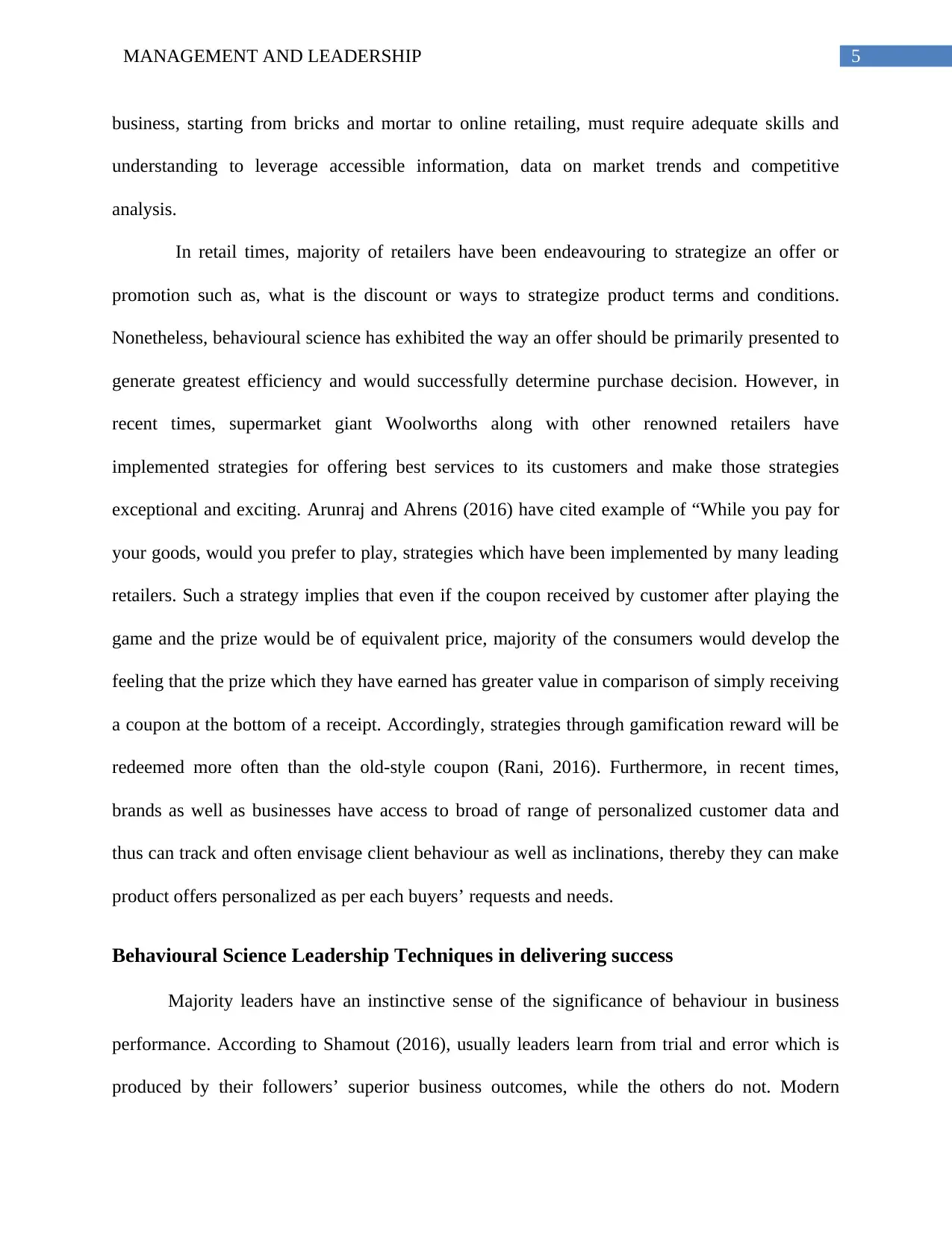
5MANAGEMENT AND LEADERSHIP
business, starting from bricks and mortar to online retailing, must require adequate skills and
understanding to leverage accessible information, data on market trends and competitive
analysis.
In retail times, majority of retailers have been endeavouring to strategize an offer or
promotion such as, what is the discount or ways to strategize product terms and conditions.
Nonetheless, behavioural science has exhibited the way an offer should be primarily presented to
generate greatest efficiency and would successfully determine purchase decision. However, in
recent times, supermarket giant Woolworths along with other renowned retailers have
implemented strategies for offering best services to its customers and make those strategies
exceptional and exciting. Arunraj and Ahrens (2016) have cited example of “While you pay for
your goods, would you prefer to play, strategies which have been implemented by many leading
retailers. Such a strategy implies that even if the coupon received by customer after playing the
game and the prize would be of equivalent price, majority of the consumers would develop the
feeling that the prize which they have earned has greater value in comparison of simply receiving
a coupon at the bottom of a receipt. Accordingly, strategies through gamification reward will be
redeemed more often than the old-style coupon (Rani, 2016). Furthermore, in recent times,
brands as well as businesses have access to broad of range of personalized customer data and
thus can track and often envisage client behaviour as well as inclinations, thereby they can make
product offers personalized as per each buyers’ requests and needs.
Behavioural Science Leadership Techniques in delivering success
Majority leaders have an instinctive sense of the significance of behaviour in business
performance. According to Shamout (2016), usually leaders learn from trial and error which is
produced by their followers’ superior business outcomes, while the others do not. Modern
business, starting from bricks and mortar to online retailing, must require adequate skills and
understanding to leverage accessible information, data on market trends and competitive
analysis.
In retail times, majority of retailers have been endeavouring to strategize an offer or
promotion such as, what is the discount or ways to strategize product terms and conditions.
Nonetheless, behavioural science has exhibited the way an offer should be primarily presented to
generate greatest efficiency and would successfully determine purchase decision. However, in
recent times, supermarket giant Woolworths along with other renowned retailers have
implemented strategies for offering best services to its customers and make those strategies
exceptional and exciting. Arunraj and Ahrens (2016) have cited example of “While you pay for
your goods, would you prefer to play, strategies which have been implemented by many leading
retailers. Such a strategy implies that even if the coupon received by customer after playing the
game and the prize would be of equivalent price, majority of the consumers would develop the
feeling that the prize which they have earned has greater value in comparison of simply receiving
a coupon at the bottom of a receipt. Accordingly, strategies through gamification reward will be
redeemed more often than the old-style coupon (Rani, 2016). Furthermore, in recent times,
brands as well as businesses have access to broad of range of personalized customer data and
thus can track and often envisage client behaviour as well as inclinations, thereby they can make
product offers personalized as per each buyers’ requests and needs.
Behavioural Science Leadership Techniques in delivering success
Majority leaders have an instinctive sense of the significance of behaviour in business
performance. According to Shamout (2016), usually leaders learn from trial and error which is
produced by their followers’ superior business outcomes, while the others do not. Modern
⊘ This is a preview!⊘
Do you want full access?
Subscribe today to unlock all pages.

Trusted by 1+ million students worldwide
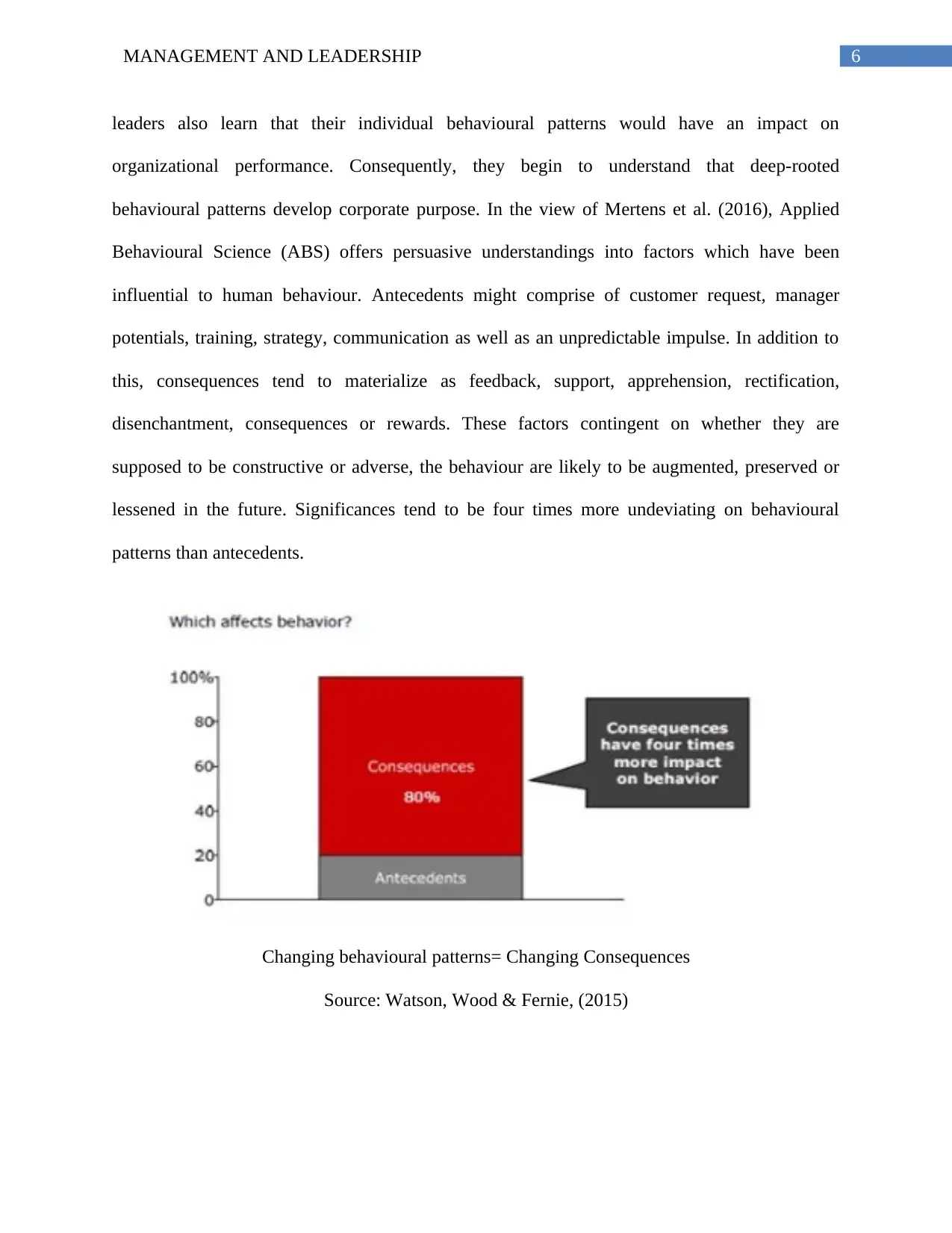
6MANAGEMENT AND LEADERSHIP
leaders also learn that their individual behavioural patterns would have an impact on
organizational performance. Consequently, they begin to understand that deep-rooted
behavioural patterns develop corporate purpose. In the view of Mertens et al. (2016), Applied
Behavioural Science (ABS) offers persuasive understandings into factors which have been
influential to human behaviour. Antecedents might comprise of customer request, manager
potentials, training, strategy, communication as well as an unpredictable impulse. In addition to
this, consequences tend to materialize as feedback, support, apprehension, rectification,
disenchantment, consequences or rewards. These factors contingent on whether they are
supposed to be constructive or adverse, the behaviour are likely to be augmented, preserved or
lessened in the future. Significances tend to be four times more undeviating on behavioural
patterns than antecedents.
Changing behavioural patterns= Changing Consequences
Source: Watson, Wood & Fernie, (2015)
leaders also learn that their individual behavioural patterns would have an impact on
organizational performance. Consequently, they begin to understand that deep-rooted
behavioural patterns develop corporate purpose. In the view of Mertens et al. (2016), Applied
Behavioural Science (ABS) offers persuasive understandings into factors which have been
influential to human behaviour. Antecedents might comprise of customer request, manager
potentials, training, strategy, communication as well as an unpredictable impulse. In addition to
this, consequences tend to materialize as feedback, support, apprehension, rectification,
disenchantment, consequences or rewards. These factors contingent on whether they are
supposed to be constructive or adverse, the behaviour are likely to be augmented, preserved or
lessened in the future. Significances tend to be four times more undeviating on behavioural
patterns than antecedents.
Changing behavioural patterns= Changing Consequences
Source: Watson, Wood & Fernie, (2015)
Paraphrase This Document
Need a fresh take? Get an instant paraphrase of this document with our AI Paraphraser
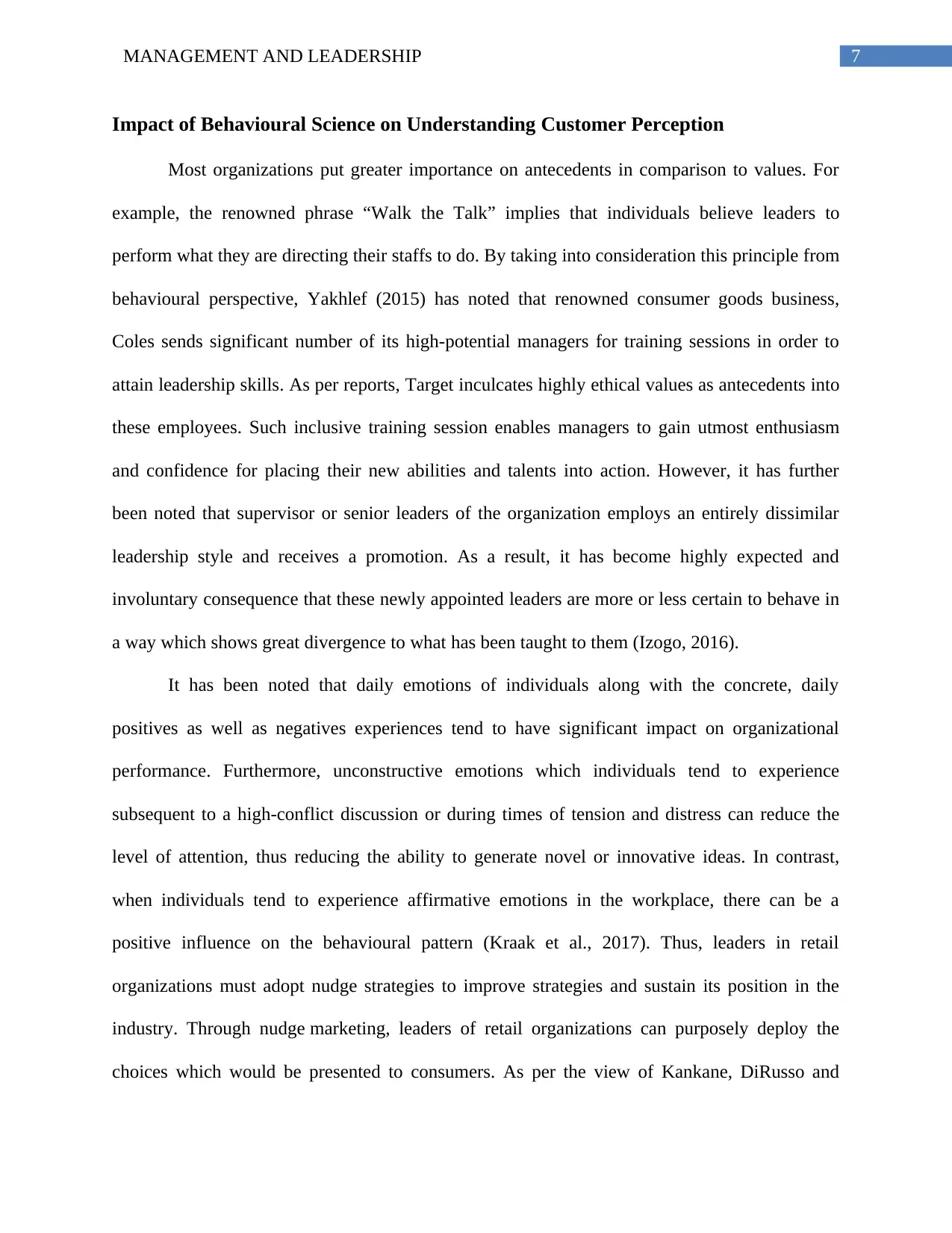
7MANAGEMENT AND LEADERSHIP
Impact of Behavioural Science on Understanding Customer Perception
Most organizations put greater importance on antecedents in comparison to values. For
example, the renowned phrase “Walk the Talk” implies that individuals believe leaders to
perform what they are directing their staffs to do. By taking into consideration this principle from
behavioural perspective, Yakhlef (2015) has noted that renowned consumer goods business,
Coles sends significant number of its high-potential managers for training sessions in order to
attain leadership skills. As per reports, Target inculcates highly ethical values as antecedents into
these employees. Such inclusive training session enables managers to gain utmost enthusiasm
and confidence for placing their new abilities and talents into action. However, it has further
been noted that supervisor or senior leaders of the organization employs an entirely dissimilar
leadership style and receives a promotion. As a result, it has become highly expected and
involuntary consequence that these newly appointed leaders are more or less certain to behave in
a way which shows great divergence to what has been taught to them (Izogo, 2016).
It has been noted that daily emotions of individuals along with the concrete, daily
positives as well as negatives experiences tend to have significant impact on organizational
performance. Furthermore, unconstructive emotions which individuals tend to experience
subsequent to a high-conflict discussion or during times of tension and distress can reduce the
level of attention, thus reducing the ability to generate novel or innovative ideas. In contrast,
when individuals tend to experience affirmative emotions in the workplace, there can be a
positive influence on the behavioural pattern (Kraak et al., 2017). Thus, leaders in retail
organizations must adopt nudge strategies to improve strategies and sustain its position in the
industry. Through nudge marketing, leaders of retail organizations can purposely deploy the
choices which would be presented to consumers. As per the view of Kankane, DiRusso and
Impact of Behavioural Science on Understanding Customer Perception
Most organizations put greater importance on antecedents in comparison to values. For
example, the renowned phrase “Walk the Talk” implies that individuals believe leaders to
perform what they are directing their staffs to do. By taking into consideration this principle from
behavioural perspective, Yakhlef (2015) has noted that renowned consumer goods business,
Coles sends significant number of its high-potential managers for training sessions in order to
attain leadership skills. As per reports, Target inculcates highly ethical values as antecedents into
these employees. Such inclusive training session enables managers to gain utmost enthusiasm
and confidence for placing their new abilities and talents into action. However, it has further
been noted that supervisor or senior leaders of the organization employs an entirely dissimilar
leadership style and receives a promotion. As a result, it has become highly expected and
involuntary consequence that these newly appointed leaders are more or less certain to behave in
a way which shows great divergence to what has been taught to them (Izogo, 2016).
It has been noted that daily emotions of individuals along with the concrete, daily
positives as well as negatives experiences tend to have significant impact on organizational
performance. Furthermore, unconstructive emotions which individuals tend to experience
subsequent to a high-conflict discussion or during times of tension and distress can reduce the
level of attention, thus reducing the ability to generate novel or innovative ideas. In contrast,
when individuals tend to experience affirmative emotions in the workplace, there can be a
positive influence on the behavioural pattern (Kraak et al., 2017). Thus, leaders in retail
organizations must adopt nudge strategies to improve strategies and sustain its position in the
industry. Through nudge marketing, leaders of retail organizations can purposely deploy the
choices which would be presented to consumers. As per the view of Kankane, DiRusso and
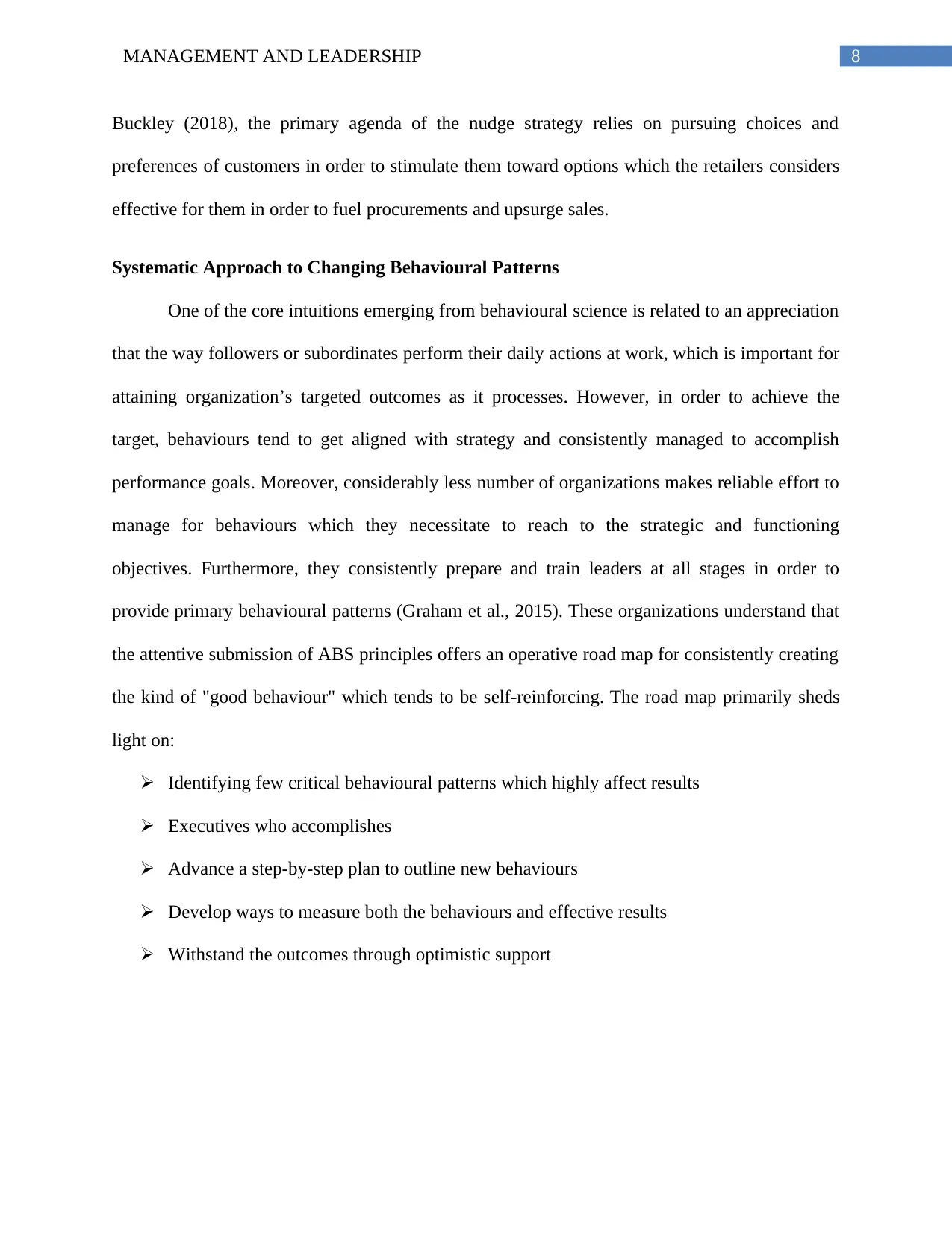
8MANAGEMENT AND LEADERSHIP
Buckley (2018), the primary agenda of the nudge strategy relies on pursuing choices and
preferences of customers in order to stimulate them toward options which the retailers considers
effective for them in order to fuel procurements and upsurge sales.
Systematic Approach to Changing Behavioural Patterns
One of the core intuitions emerging from behavioural science is related to an appreciation
that the way followers or subordinates perform their daily actions at work, which is important for
attaining organization’s targeted outcomes as it processes. However, in order to achieve the
target, behaviours tend to get aligned with strategy and consistently managed to accomplish
performance goals. Moreover, considerably less number of organizations makes reliable effort to
manage for behaviours which they necessitate to reach to the strategic and functioning
objectives. Furthermore, they consistently prepare and train leaders at all stages in order to
provide primary behavioural patterns (Graham et al., 2015). These organizations understand that
the attentive submission of ABS principles offers an operative road map for consistently creating
the kind of "good behaviour" which tends to be self-reinforcing. The road map primarily sheds
light on:
Identifying few critical behavioural patterns which highly affect results
Executives who accomplishes
Advance a step-by-step plan to outline new behaviours
Develop ways to measure both the behaviours and effective results
Withstand the outcomes through optimistic support
Buckley (2018), the primary agenda of the nudge strategy relies on pursuing choices and
preferences of customers in order to stimulate them toward options which the retailers considers
effective for them in order to fuel procurements and upsurge sales.
Systematic Approach to Changing Behavioural Patterns
One of the core intuitions emerging from behavioural science is related to an appreciation
that the way followers or subordinates perform their daily actions at work, which is important for
attaining organization’s targeted outcomes as it processes. However, in order to achieve the
target, behaviours tend to get aligned with strategy and consistently managed to accomplish
performance goals. Moreover, considerably less number of organizations makes reliable effort to
manage for behaviours which they necessitate to reach to the strategic and functioning
objectives. Furthermore, they consistently prepare and train leaders at all stages in order to
provide primary behavioural patterns (Graham et al., 2015). These organizations understand that
the attentive submission of ABS principles offers an operative road map for consistently creating
the kind of "good behaviour" which tends to be self-reinforcing. The road map primarily sheds
light on:
Identifying few critical behavioural patterns which highly affect results
Executives who accomplishes
Advance a step-by-step plan to outline new behaviours
Develop ways to measure both the behaviours and effective results
Withstand the outcomes through optimistic support
⊘ This is a preview!⊘
Do you want full access?
Subscribe today to unlock all pages.

Trusted by 1+ million students worldwide
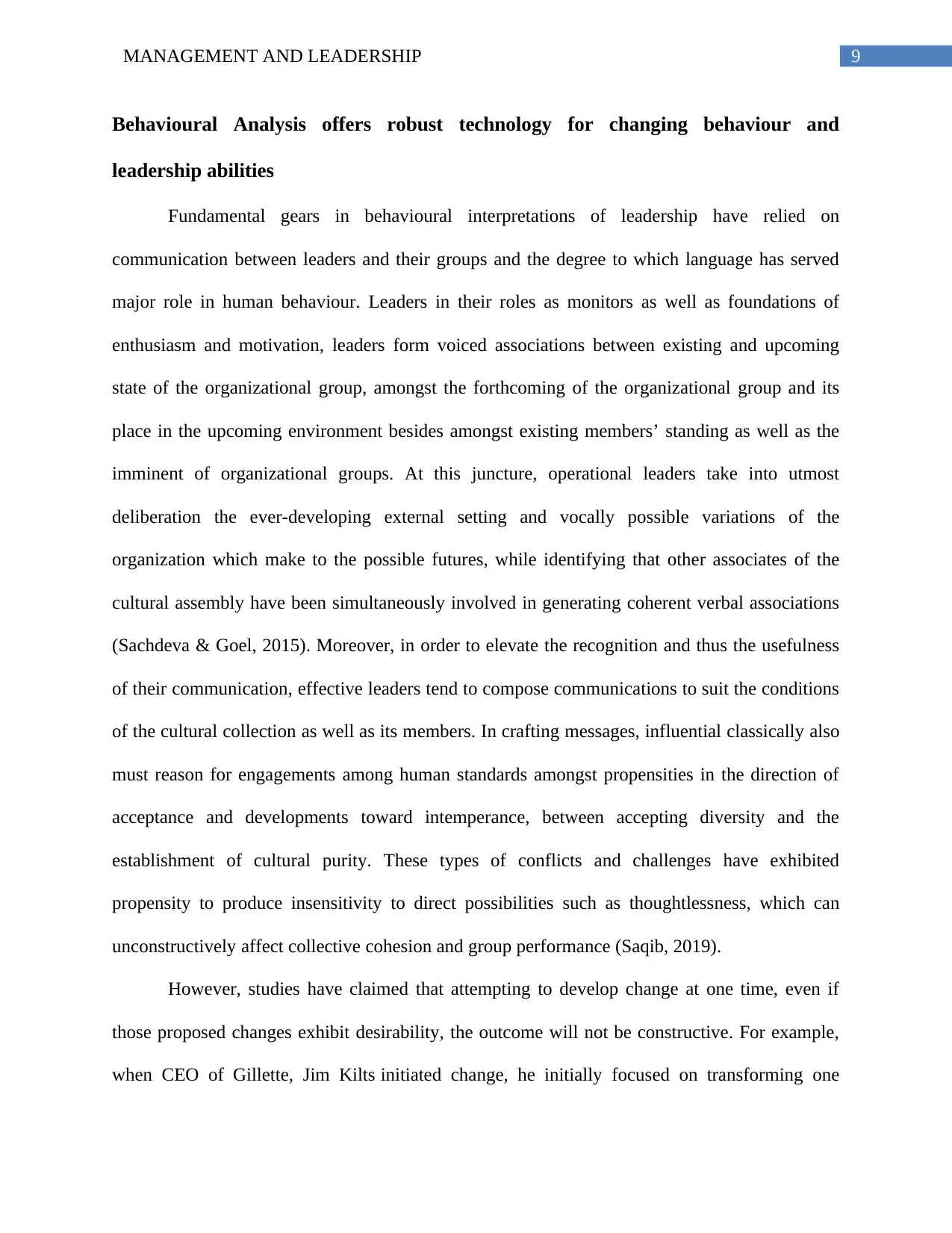
9MANAGEMENT AND LEADERSHIP
Behavioural Analysis offers robust technology for changing behaviour and
leadership abilities
Fundamental gears in behavioural interpretations of leadership have relied on
communication between leaders and their groups and the degree to which language has served
major role in human behaviour. Leaders in their roles as monitors as well as foundations of
enthusiasm and motivation, leaders form voiced associations between existing and upcoming
state of the organizational group, amongst the forthcoming of the organizational group and its
place in the upcoming environment besides amongst existing members’ standing as well as the
imminent of organizational groups. At this juncture, operational leaders take into utmost
deliberation the ever-developing external setting and vocally possible variations of the
organization which make to the possible futures, while identifying that other associates of the
cultural assembly have been simultaneously involved in generating coherent verbal associations
(Sachdeva & Goel, 2015). Moreover, in order to elevate the recognition and thus the usefulness
of their communication, effective leaders tend to compose communications to suit the conditions
of the cultural collection as well as its members. In crafting messages, influential classically also
must reason for engagements among human standards amongst propensities in the direction of
acceptance and developments toward intemperance, between accepting diversity and the
establishment of cultural purity. These types of conflicts and challenges have exhibited
propensity to produce insensitivity to direct possibilities such as thoughtlessness, which can
unconstructively affect collective cohesion and group performance (Saqib, 2019).
However, studies have claimed that attempting to develop change at one time, even if
those proposed changes exhibit desirability, the outcome will not be constructive. For example,
when CEO of Gillette, Jim Kilts initiated change, he initially focused on transforming one
Behavioural Analysis offers robust technology for changing behaviour and
leadership abilities
Fundamental gears in behavioural interpretations of leadership have relied on
communication between leaders and their groups and the degree to which language has served
major role in human behaviour. Leaders in their roles as monitors as well as foundations of
enthusiasm and motivation, leaders form voiced associations between existing and upcoming
state of the organizational group, amongst the forthcoming of the organizational group and its
place in the upcoming environment besides amongst existing members’ standing as well as the
imminent of organizational groups. At this juncture, operational leaders take into utmost
deliberation the ever-developing external setting and vocally possible variations of the
organization which make to the possible futures, while identifying that other associates of the
cultural assembly have been simultaneously involved in generating coherent verbal associations
(Sachdeva & Goel, 2015). Moreover, in order to elevate the recognition and thus the usefulness
of their communication, effective leaders tend to compose communications to suit the conditions
of the cultural collection as well as its members. In crafting messages, influential classically also
must reason for engagements among human standards amongst propensities in the direction of
acceptance and developments toward intemperance, between accepting diversity and the
establishment of cultural purity. These types of conflicts and challenges have exhibited
propensity to produce insensitivity to direct possibilities such as thoughtlessness, which can
unconstructively affect collective cohesion and group performance (Saqib, 2019).
However, studies have claimed that attempting to develop change at one time, even if
those proposed changes exhibit desirability, the outcome will not be constructive. For example,
when CEO of Gillette, Jim Kilts initiated change, he initially focused on transforming one
Paraphrase This Document
Need a fresh take? Get an instant paraphrase of this document with our AI Paraphraser
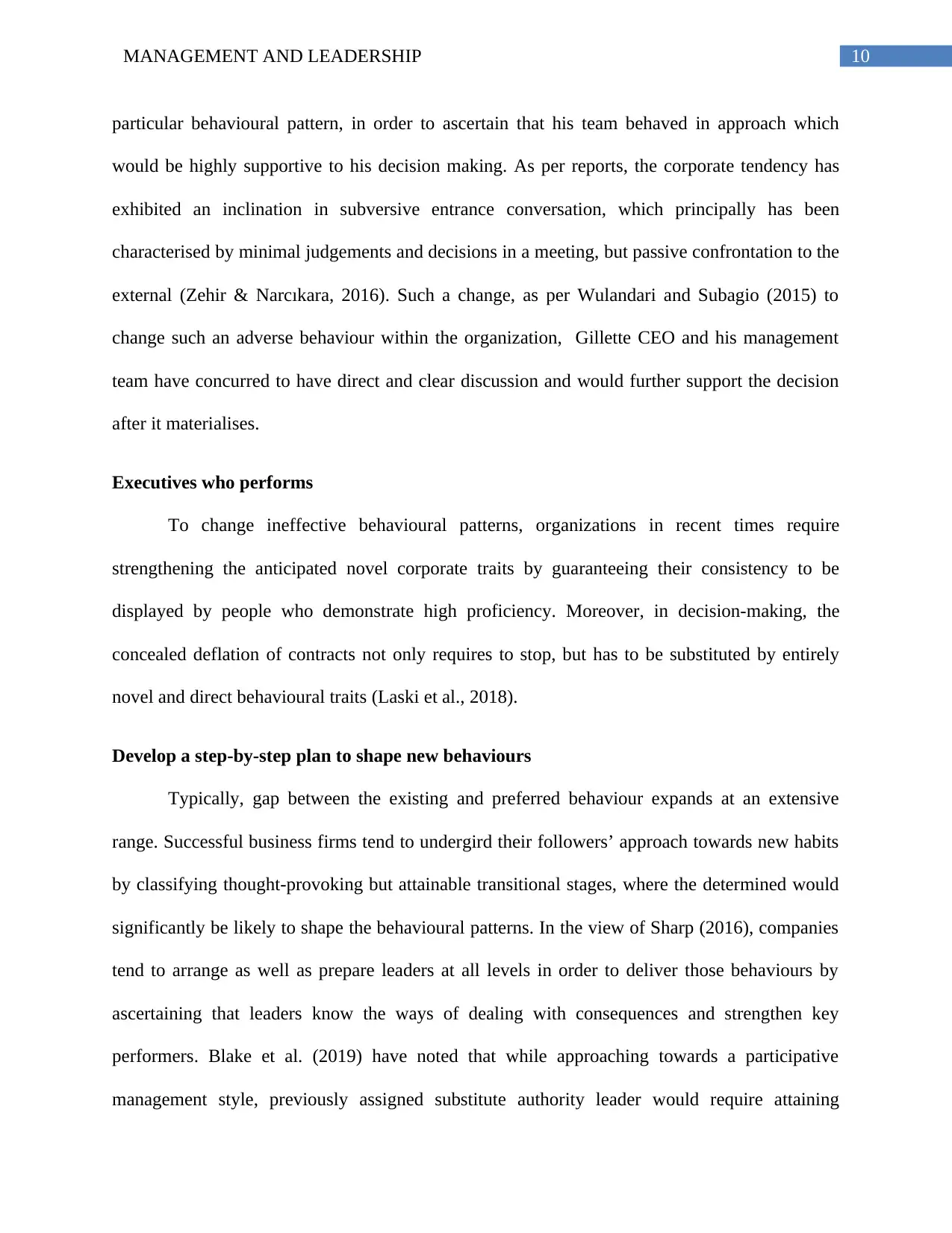
10MANAGEMENT AND LEADERSHIP
particular behavioural pattern, in order to ascertain that his team behaved in approach which
would be highly supportive to his decision making. As per reports, the corporate tendency has
exhibited an inclination in subversive entrance conversation, which principally has been
characterised by minimal judgements and decisions in a meeting, but passive confrontation to the
external (Zehir & Narcıkara, 2016). Such a change, as per Wulandari and Subagio (2015) to
change such an adverse behaviour within the organization, Gillette CEO and his management
team have concurred to have direct and clear discussion and would further support the decision
after it materialises.
Executives who performs
To change ineffective behavioural patterns, organizations in recent times require
strengthening the anticipated novel corporate traits by guaranteeing their consistency to be
displayed by people who demonstrate high proficiency. Moreover, in decision-making, the
concealed deflation of contracts not only requires to stop, but has to be substituted by entirely
novel and direct behavioural traits (Laski et al., 2018).
Develop a step-by-step plan to shape new behaviours
Typically, gap between the existing and preferred behaviour expands at an extensive
range. Successful business firms tend to undergird their followers’ approach towards new habits
by classifying thought-provoking but attainable transitional stages, where the determined would
significantly be likely to shape the behavioural patterns. In the view of Sharp (2016), companies
tend to arrange as well as prepare leaders at all levels in order to deliver those behaviours by
ascertaining that leaders know the ways of dealing with consequences and strengthen key
performers. Blake et al. (2019) have noted that while approaching towards a participative
management style, previously assigned substitute authority leader would require attaining
particular behavioural pattern, in order to ascertain that his team behaved in approach which
would be highly supportive to his decision making. As per reports, the corporate tendency has
exhibited an inclination in subversive entrance conversation, which principally has been
characterised by minimal judgements and decisions in a meeting, but passive confrontation to the
external (Zehir & Narcıkara, 2016). Such a change, as per Wulandari and Subagio (2015) to
change such an adverse behaviour within the organization, Gillette CEO and his management
team have concurred to have direct and clear discussion and would further support the decision
after it materialises.
Executives who performs
To change ineffective behavioural patterns, organizations in recent times require
strengthening the anticipated novel corporate traits by guaranteeing their consistency to be
displayed by people who demonstrate high proficiency. Moreover, in decision-making, the
concealed deflation of contracts not only requires to stop, but has to be substituted by entirely
novel and direct behavioural traits (Laski et al., 2018).
Develop a step-by-step plan to shape new behaviours
Typically, gap between the existing and preferred behaviour expands at an extensive
range. Successful business firms tend to undergird their followers’ approach towards new habits
by classifying thought-provoking but attainable transitional stages, where the determined would
significantly be likely to shape the behavioural patterns. In the view of Sharp (2016), companies
tend to arrange as well as prepare leaders at all levels in order to deliver those behaviours by
ascertaining that leaders know the ways of dealing with consequences and strengthen key
performers. Blake et al. (2019) have noted that while approaching towards a participative
management style, previously assigned substitute authority leader would require attaining
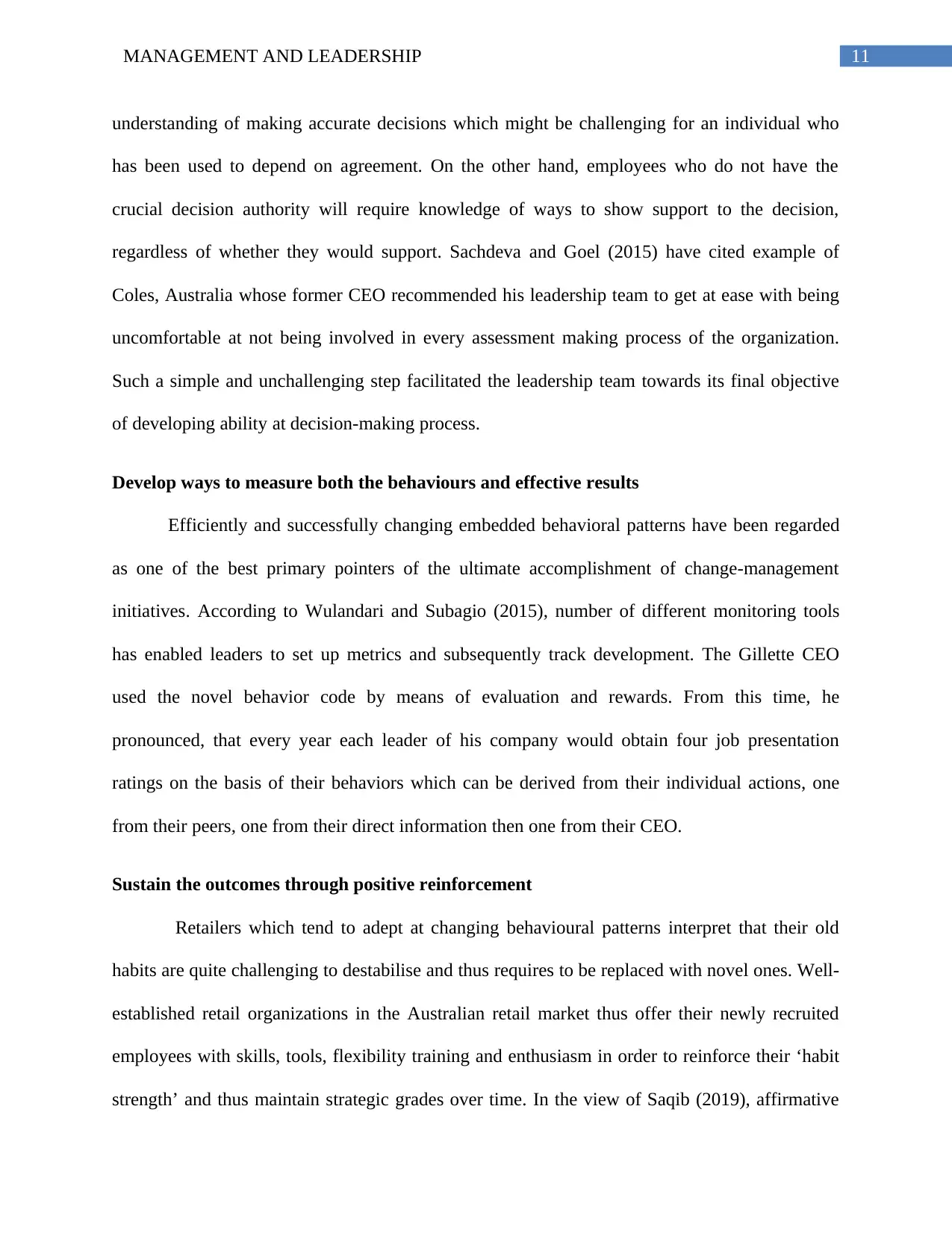
11MANAGEMENT AND LEADERSHIP
understanding of making accurate decisions which might be challenging for an individual who
has been used to depend on agreement. On the other hand, employees who do not have the
crucial decision authority will require knowledge of ways to show support to the decision,
regardless of whether they would support. Sachdeva and Goel (2015) have cited example of
Coles, Australia whose former CEO recommended his leadership team to get at ease with being
uncomfortable at not being involved in every assessment making process of the organization.
Such a simple and unchallenging step facilitated the leadership team towards its final objective
of developing ability at decision-making process.
Develop ways to measure both the behaviours and effective results
Efficiently and successfully changing embedded behavioral patterns have been regarded
as one of the best primary pointers of the ultimate accomplishment of change-management
initiatives. According to Wulandari and Subagio (2015), number of different monitoring tools
has enabled leaders to set up metrics and subsequently track development. The Gillette CEO
used the novel behavior code by means of evaluation and rewards. From this time, he
pronounced, that every year each leader of his company would obtain four job presentation
ratings on the basis of their behaviors which can be derived from their individual actions, one
from their peers, one from their direct information then one from their CEO.
Sustain the outcomes through positive reinforcement
Retailers which tend to adept at changing behavioural patterns interpret that their old
habits are quite challenging to destabilise and thus requires to be replaced with novel ones. Well-
established retail organizations in the Australian retail market thus offer their newly recruited
employees with skills, tools, flexibility training and enthusiasm in order to reinforce their ‘habit
strength’ and thus maintain strategic grades over time. In the view of Saqib (2019), affirmative
understanding of making accurate decisions which might be challenging for an individual who
has been used to depend on agreement. On the other hand, employees who do not have the
crucial decision authority will require knowledge of ways to show support to the decision,
regardless of whether they would support. Sachdeva and Goel (2015) have cited example of
Coles, Australia whose former CEO recommended his leadership team to get at ease with being
uncomfortable at not being involved in every assessment making process of the organization.
Such a simple and unchallenging step facilitated the leadership team towards its final objective
of developing ability at decision-making process.
Develop ways to measure both the behaviours and effective results
Efficiently and successfully changing embedded behavioral patterns have been regarded
as one of the best primary pointers of the ultimate accomplishment of change-management
initiatives. According to Wulandari and Subagio (2015), number of different monitoring tools
has enabled leaders to set up metrics and subsequently track development. The Gillette CEO
used the novel behavior code by means of evaluation and rewards. From this time, he
pronounced, that every year each leader of his company would obtain four job presentation
ratings on the basis of their behaviors which can be derived from their individual actions, one
from their peers, one from their direct information then one from their CEO.
Sustain the outcomes through positive reinforcement
Retailers which tend to adept at changing behavioural patterns interpret that their old
habits are quite challenging to destabilise and thus requires to be replaced with novel ones. Well-
established retail organizations in the Australian retail market thus offer their newly recruited
employees with skills, tools, flexibility training and enthusiasm in order to reinforce their ‘habit
strength’ and thus maintain strategic grades over time. In the view of Saqib (2019), affirmative
⊘ This is a preview!⊘
Do you want full access?
Subscribe today to unlock all pages.

Trusted by 1+ million students worldwide
1 out of 18
Related Documents
Your All-in-One AI-Powered Toolkit for Academic Success.
+13062052269
info@desklib.com
Available 24*7 on WhatsApp / Email
![[object Object]](/_next/static/media/star-bottom.7253800d.svg)
Unlock your academic potential
Copyright © 2020–2025 A2Z Services. All Rights Reserved. Developed and managed by ZUCOL.





